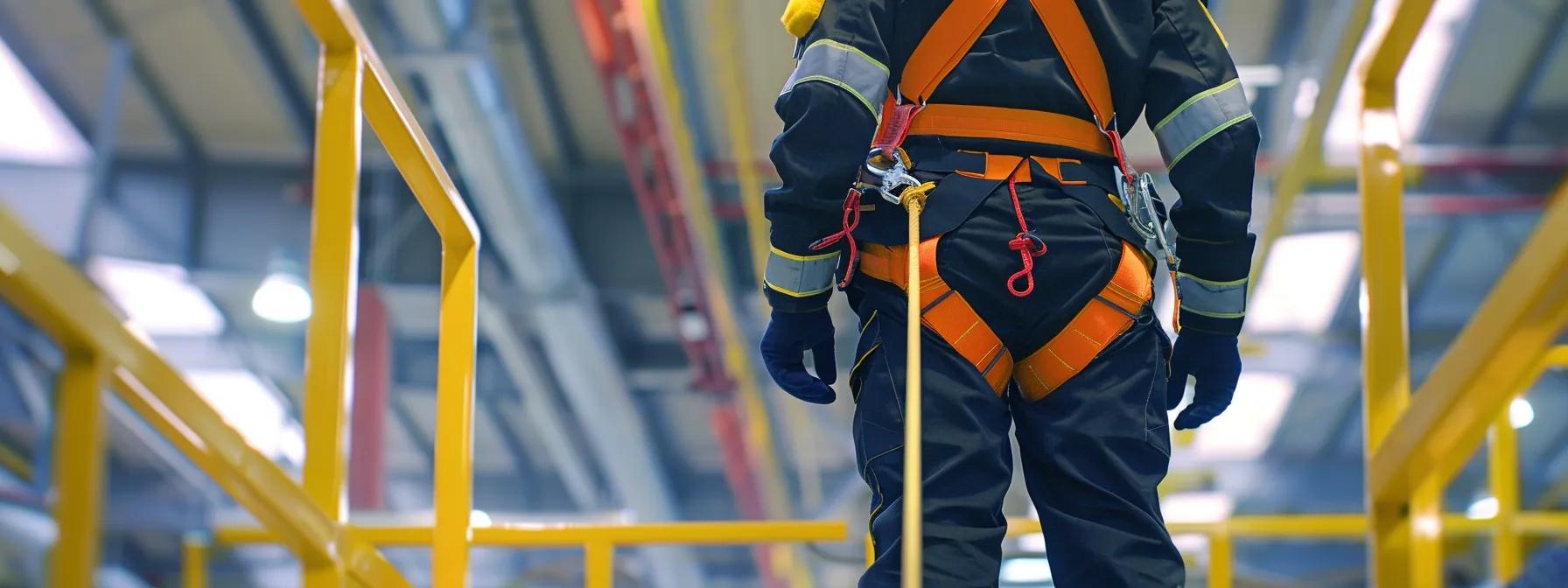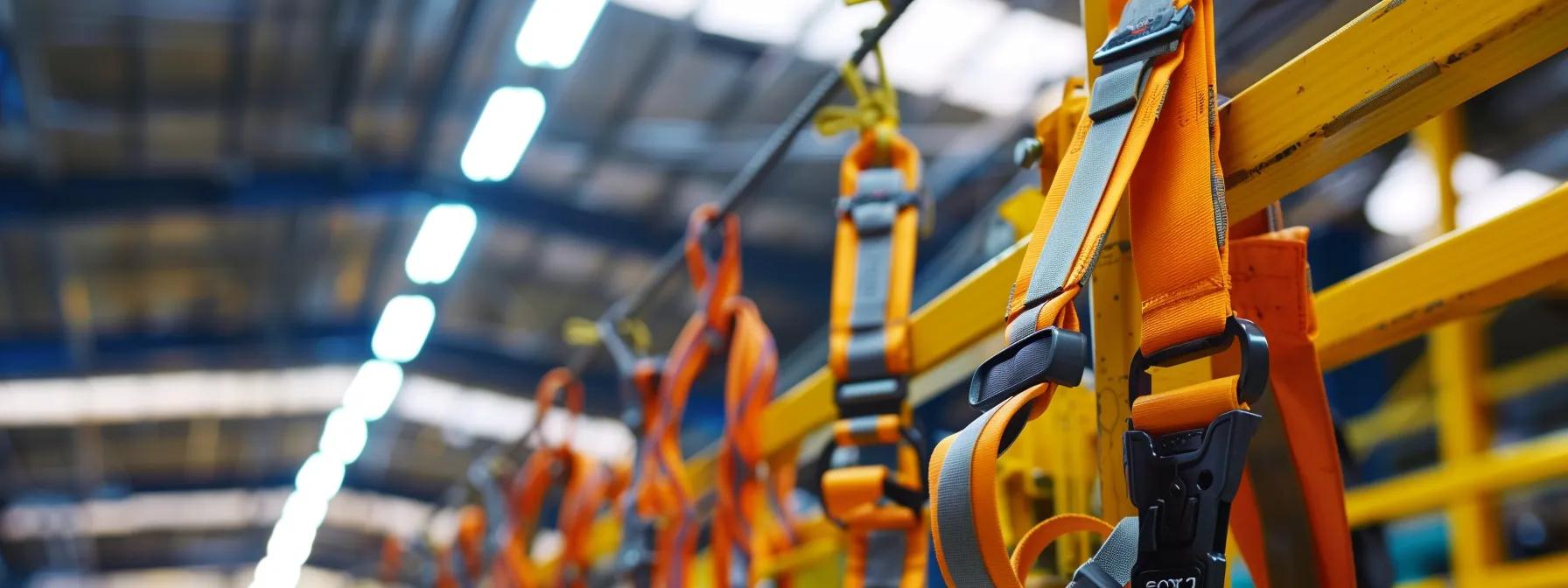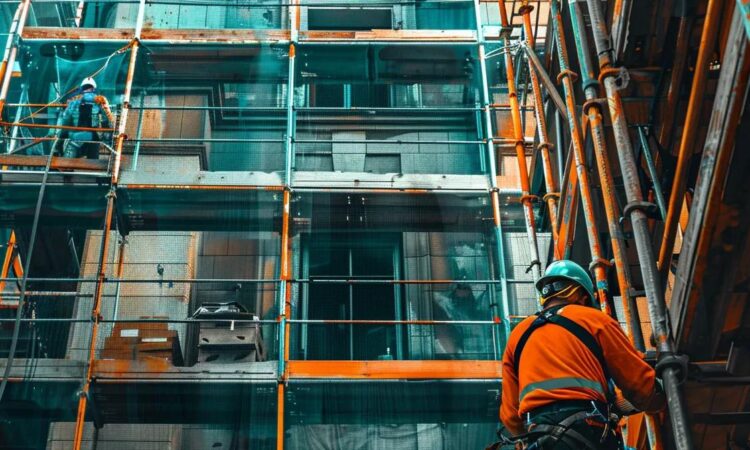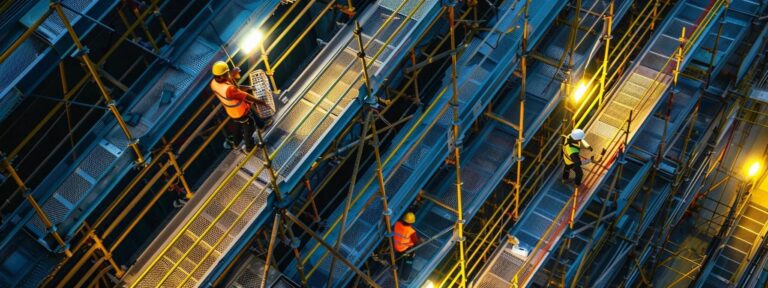Personal Fall Arrest vs. Fall Restraint Systems: Complete Guide
This article provides a comprehensive overview of personal fall arrest systems and fall restraint systems, including lifeline systems, their working mechanisms, key components such as design installation and annual maintenance, applications, and regulatory requirements in industries-we-serve. The discussion is designed for professionals seeking complete information on selecting and using these systems effectively in workplaces with fall hazards.
Defining Personal Fall Arrest Systems and Their Primary Function
Personal fall arrest systems (PFAS), when complemented with proper design installation, are engineered to stop a worker during a fall from elevation by immediately arresting a free fall before the worker reaches a lower level. They work by absorbing and dissipating the falling body’s kinetic energy through components such as safety harnesses, lanyards, deceleration devices, connectors, and secure anchorage points. These systems are critical for roofing, construction, or maintenance on elevated platforms within our industries-we-serve, reducing fall-related injuries by over 60% when properly implemented along with regular annual maintenance. For further information or to get-a-free-quote, please visit usfallprotection.com.
Understanding How Personal Fall Arrest Systems Work to Stop a Fall
PFAS detect a fall and immediately engage shock absorbers and lanyards that gradually decelerate the falling worker while ensuring ladder systems integration. Engineered elongation and energy absorption features, combined with lifeline systems and guardrail systems, restrict speed and allow sufficient time to arrest the fall before impact.
Key Components of a Personal Fall Arrest System
The system consists of a safety harness that distributes forces over the upper body, lanyards, deceleration devices, connectors or carabiners, and anchorage points rated to sustain forces up to 5,000 pounds. This robust design installation ensures that each setup adheres to strict safety requirements. Each component works together with dedicated annual maintenance practices and integrated lifeline systems to manage the force of a fall and minimize injury.
Situations Requiring Personal Fall Arrest Systems
PFAS are required where workers face fall hazards from elevations exceeding six feet, on sloped roofs, platforms, or any surfaces lacking adequate guardrail systems. They are essential in construction sites, multi-story building maintenance, and industrial environments with open edges or floor openings, especially when unexpected slips or structural failures occur. In these settings, ladder systems and lifeline systems play a critical role as part of design installation and annual maintenance practices, ensuring that industries-we-serve receive reliable protection.
The Role of Safety Harness Systems in Fall Arrest
Safety harnesses are the backbone of PFAS and play a vital role in industries-we-serve. A correctly fitted and adjusted harness supports the body during a fall, redistributing force to strong body parts such as the thighs, pelvis, and shoulders. This design installation is key in facilitating annual maintenance and effective safety measures, reducing injury risks and suspension trauma during prolonged hanging.
Calculating Fall Clearance for Personal Fall Arrest Systems
Effective fall clearance involves calculating the free fall distance, the deceleration distance provided by the system, and the height of the anchorage. In many lifeline systems scenarios, design installation practices are crucial for ensuring that safety measures meet industry standards. Best practices suggest that clearance should be at least 6 feet greater than the free fall distance to create an adequate buffer and allow safe rescue. Furthermore, regular annual maintenance of ladder systems and guardrail systems is essential to maintain reliable performance.
Defining Fall Restraint Systems and Their Protective Goal

Fall restraint systems, including guardrail systems and lifeline systems, prevent workers from reaching a fall hazard instead of arresting an ongoing fall. They limit worker movement to keep them safely away from dangerous areas, a method particularly useful when it is preferable to eliminate the possibility of falling altogether. Companies in industries-we-serve benefit from our design installation and annual maintenance practices to ensure peak safety performance.
How Fall Restraint Systems Prevent Access to Fall Hazards
These systems employ barriers, guardrails, fixed lines, and restraint lanyards to restrict movement toward unprotected edges or openings, ensuring that workers remain within a safe work zone, even in areas with continuously exposed hazards such as skylights or elevated platforms. In many facilities, guardrail systems and lifeline systems are integrated as part of a comprehensive design installation plan, complemented by consistent annual maintenance. Additionally, ladder systems are often utilized across industries-we-serve to further reinforce safety measures and meet regulatory standards.
Essential Components of Fall Restraint Systems
Key components include fixed anchorage points, restraint lanyards, lifeline systems, connecting hardware like carabiners and lanyard reels, and sometimes engineered barriers or guardrail systems. These components are designed for design installation and annual maintenance, strictly limiting a worker’s range of motion toward hazardous edges. They are commonly integrated in ladder systems, and you can learn more about our solutions on industries-we-serve pages at usfallprotection.com—plus, feel free to get-a-free-quote via our blog for further details.
Ideal Scenarios for Using Fall Restraint Systems
Fall restraint systems, combined with lifeline systems, are best for environments where continuous prevention is needed. In industries-we-serve such as open-sided plants, elevated structures with known drop hazards, or work near skylights and large floor openings, regular annual maintenance ensures optimal safety. Their design secures safe mobility without exposing workers to fall hazards.
Understanding the Limitations of Fall Restraint Equipment
While effective in preventing falls, these lifeline systems and guardrail systems do not arrest a fall if a worker bypasses the restraints. Improper design installation or skipped annual maintenance can also compromise their function. Regular inspections and adherence to regulatory standards are essential.
Personal Fall Arrest vs. Fall Restraint: Key Mechanism Differences
Personal fall arrest and fall restraint systems differ fundamentally: PFAS, such as lifeline systems, are reactive and engage after a fall begins, while fall restraint systems, including guardrail systems, are proactive by limiting movement to avoid exposure. Both approaches are chosen based on the specific work environment (industries-we-serve) and risk assessment.
Arresting a Fall vs. Preventing a Fall: The Fundamental Contrast
PFAS activate after a fall to mitigate its effects, whereas fall restraint systems eliminate the possibility of a fall by restricting movement. In many industries-we-serve, professionals integrate lifeline systems and guardrail systems into their projects through a careful design installation process paired with annual maintenance to ensure optimal safety. The choice depends on work conditions and the acceptable level of risk.
Differences in Required Anchorage Strength
PFAS anchorage with proper design installation must support dynamic loads (up to 5,000 pounds) to absorb fall energy, while fall restraint anchorage—complemented by lifeline systems and supported by annual maintenance—requires sufficient strength to resist movement, though dynamic load is not a factor.
Variations in Body Wear: Full Body Harnesses vs. Belts
For PFAS, full body harnesses and lifeline systems are mandatory to distribute forces during a fall, while fall restraint systems (often complemented by guardrail systems) may use lower-body belts since they only need to limit movement without absorbing energy. For further guidance and solutions, please visit usfallprotection.com.
Connecting Devices: Lanyards and Lifelines in Each System
PFAS connecting devices include shock absorption to reduce impact force, while fall restraint systems use non-elastic connectors solely to keep workers within safe limits.
Rescue Planning Considerations for Each System Type
Since pfas can leave a worker suspended, prompt rescue plans and annual maintenance are critical to prevent suspension trauma. Fall restraint systems, along with lifeline systems and guardrail systems, require rescue protocols too, though the risk is lower since free fall does not occur.
Examining Safety Harness Systems as a Critical Component

Safety harness systems are central to both PFAS and fall restraint strategies. Their proper design, fitting, and maintenance directly influence the effectiveness of a fall protection program.
Types of Safety Harnesses and Their Applications
Common types include full body harnesses, sit harnesses, and positioning harnesses; these are frequently paired with lifeline systems for enhanced safety. Full body harnesses are standard in PFAS, while sit or positioning harnesses may be used in fall restraint applications that require greater mobility and thoughtful design installation in industries-we-serve settings.
Proper Fitting and Adjustment of Safety Harness Systems
A harness must be fitted snugly without excess tightness, particularly when integrated with ladder systems during design installation; proper adjustment ensures comfort and optimal load distribution. Regular training on correct fitting, along with annual maintenance as recommended by lifeline systems guidelines, is essential.
Inspection and Maintenance Requirements for Safety Harnesses
Regular inspections for webbing wear, damaged buckles, or stitching issues, combined with annual maintenance protocols, are critical. A competent person should check equipment routinely and, where ladder systems are applicable, remove any damaged gear to ensure consistent compliance with OSHA standards. For further resources, visit usfallprotection.com.
The Importance of D-Ring Placement on Safety Harnesses
The D-ring serves as the primary connection for lifeline systems, lanyards, or lifelines. Correct positioning on the upper back minimizes unwanted body movement and directs forces downward, enhancing safety effectiveness and ensuring annual maintenance is performed properly. For more information, visit usfallprotection.com.
Understanding Suspension Trauma and Mitigation Strategies
Suspension trauma results when a worker hangs in a harness too long, restricting blood flow. Incorporating lifeline systems into the setup, along with proper design installation and annual maintenance, ensures that ladder systems and guardrail systems are always in optimal condition. Reducing free fall distance through these measures, ensuring rapid rescue, and providing training on self-rescue techniques help mitigate this risk.
Selecting the Appropriate System: Personal Fall Arrest or Fall Restraint
The selection between PFAS and fall restraint systems is based on detailed risk assessments that consider factors like mobility, proximity to hazards, and free fall distance.
Assessing Workplace Hazards to Determine System Needs
Evaluating elevation, potential fall distances, environmental conditions, and task-specific risks is essential, which is why our design installation standards are rigorously followed. Tasks on scaffolding or near unprotected edges may require robust PFAS and lifeline systems, while defined areas may only need fall restraint and guardrail systems. For inquiries, please visit our get-a-free-quote page.
Considering Work Area Mobility and Edge Proximity
In dynamic work areas where frequent movement is required, a fall restraint system such as ladder systems that limits reach without hindering mobility is preferable. In more static situations, PFAS—often integrated with guardrail systems for design installation and supported by annual maintenance protocols—can be used to safely arrest a potential fall. For further insights into our industries-we-serve and solution offerings, please visit usfallprotection.com.
Evaluating Free Fall Distance and Obstruction Clearance
Sufficient clearance is critical for PFAS to work effectively; proper design installation and annual maintenance are essential to ensure that these systems perform reliably. If clearance is inadequate, injury risk increases. Fall restraint systems, often complemented by guardrail systems, must also ensure that restrained workers do not contact obstructions.
The Hierarchy of Controls in Fall Protection Choices
Regulatory guidelines stress using engineering controls first. When those are impractical, fall restraint systems prevent exposure, and PFAS are used when prevention is not entirely possible.
When a Combined Approach Might Be Necessary
In complex environments, both systems may be used together. This layered approach prevents workers from reaching hazards while providing a backup arrest mechanism if a fall occurs.
Regulatory Standards and Best Practices for Fall Protection Systems

Compliance with OSHA, ANSI, and other guidelines is essential. Both PFAS and fall restraint systems must meet strict regulatory standards to ensure safety and minimize liabilities.
Overview of OSHA Requirements for Personal Fall Arrest Systems
OSHA mandates that PFAS withstand forces of at least 5,000 pounds. Requirements include proper anchorage, shock absorber integration, and thorough employee training in safe use.
OSHA Guidelines for Fall Restraint Systems
For fall restraint systems, OSHA requires proper design installation that effectively prevents a worker from reaching unprotected edges, integrating lifeline systems to enhance overall protection. Regular inspections, annual maintenance, and proper training are also necessary.
Training Imperatives for Workers Using Fall Protection
Training should cover equipment selection, proper use, limitations, and annual maintenance. Workers need to know rescue procedures with lifeline systems and the correct harness fitting techniques, with regular refresher courses to maintain safety standards.
The Role of a Competent Person in System Oversight
A designated competent person must manage installation, inspection, and maintenance of all fall protection systems. Their oversight ensures compliance and addresses any deficiencies promptly.
Regular Equipment Inspection and Maintenance Protocols
Routine inspections should verify anchorage integrity, connector conditions, and harness wear, with particular attention to ladder systems and guardrail systems to ensure maximum safety. Maintenance practices such as cleaning, part replacement, and recalibration—aligned with annual maintenance routines—are vital for ongoing regulatory compliance. For further information, please visit our about us page or explore the industries-we-serve section on usfallprotection.com for design installation insights.
Frequently Asked Questions
Q: What is the primary purpose of a personal fall arrest system?
A: It is designed to safely stop a worker’s fall by absorbing energy and decelerating the fall.
Q: How do fall restraint systems differ from personal fall arrest systems?
A: Fall restraint prevents a worker from reaching dangerous areas, while PFAS acts after a fall begins.
Q: Why is proper fitting of a safety harness important?
A: Proper fitting distributes fall forces across the body, reducing injury risk and suspension trauma.
Q: What are common criteria for calculating fall clearance?
A: Free fall distance, deceleration distance, and an added safety margin are combined to provide sufficient clearance.
Q: Who should oversee the inspection of fall protection equipment?
A: A competent person, trained in fall protection systems, should conduct regular inspections.
Q: Can fall arrest and fall restraint systems be used together?
A: Yes, a combined approach can offer both preventive and arrest protections.
Q: What regulatory standards apply to fall protection systems?
A: OSHA, ANSI, and industry-specific guidelines define performance and maintenance requirements.
Q: How is suspension trauma prevented in workers using PFAS?
A: By reducing free fall distance, ensuring rapid rescue, and using harness designs that relieve pressure points.
Final Thoughts
In summary, personal fall arrest systems and fall restraint systems each play distinct yet complementary roles in worker safety. PFAS is designed to arrest a fall already in progress, while fall restraint systems prevent workers from reaching hazardous areas. Both require detailed installation, regular maintenance, proper training, and adherence to regulatory standards. A thorough risk assessment is key to selecting the appropriate system or combination for a given work environment, ensuring enhanced safety and compliance.
Below is a summary table comparing key aspects of these systems:
| System Type | Primary Function | Key Components | Critical Considerations | Typical Use Cases |
|---|---|---|---|---|
| Personal Fall Arrest | Arresting a fall in progress | Safety harness, lanyards, anchorage, decelerator | Adequate clearance, rescue planning | Rooftop maintenance, construction at elevations |
| Fall Restraint | Preventing access to fall hazards | Restraint lanyards, fixed anchorage, barriers | Restricting movement, proper installation | Work near unguarded edges, skylight protection |
This table illustrates how each system’s components and requirements align with their protective roles. Organizations should use this information along with professional risk assessments to choose the system or combination that best meets their operational needs, ensuring worker safety and compliance while effectively managing fall hazards.




